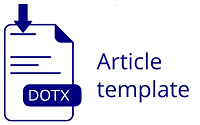Pengaruh Electronic Word Of Mouth (E-WOM) Terhadap Minat Berkunjung Melalui Citra Destinasi Pada Wisata Taman Rekreasi Kota Bangkalan
Abstract
The development of the use of internet and social media is an oppurtunity for a tourist destination to increase the visitors. Likewise with TRK tour which is said still have minimal visitors, therefore there is a need information containing a special specification of TRK to triggers visit intention to make visit such as the destination image that is through EWOM. The purpose of this research was to find out how much influence EWOM has on visiting intention through destination image on Taman Rekreasi Kota in Bangkalan. This research using quantitative research with survey method via questionaire. The data analysis technique used to prove the hypothesis was compiled using Path Analysis and using the Sobel Test. The results of this research show that (1) EWOM has a direct, significant effect on visisting intentions; (2) EWOM has a direct effect on destination image; (3) The destination image has no effect on visiting interest and is not significant; (4) EWOM has limited indirect effect on visiting intention through the destination image, the destination image is able to mediate the effect between the Electronic Word Of Mouth on visiting intention. The researcher can conclude that the use of Electronic Word Of Mouth can influence the visiting intention and destination image is able to mediate it, but the mediating variable does not have much influence on the visiting intention.
Full Text:
PDFReferences
Aprilia, F., & Kusumawati, A. (2021). Influence of Electronic Word of Mouth on Visitor’s Interest to Tourism Destinations. Journal of Asian Finance, Economics and Business, 8(2), 993–1003. https://doi.org/10.13106/jafeb.2021.vol8.no2.0993
Ferdinand, A. (2014). Metode Penelitian Manajemen: Pedoman Penelitian untuk Skripsi, Tesis disertai Ilmu Manajemen. Universitas Diponegoro.
Ghozali. (2016). Aplikasi Analisis Multivariate: Dengan Program IBM SPSS 23. Badan Penerbit Universitas Diponegoro. (2016). The implication of firm-specific characteristics on disclosure: the case of Indonesia.International Journal of Monetary Economics and Finance, 9 (4), 379–387.
Goyette I., Ricard, L., J., B., & F., M. (2010). e‐WOM Scale: word‐of‐mouth measurement scale for e‐services context. Canadian Journal of Administrative Sciences/Revue Canadienne Des Sciences de l’Administration, 27(1), 5–23.
Iswara, G. A. N., & Santika, I. W. (2019). Peran Citra Merek Dalam Memediasi Pengaruh E-Wom Terhadap Minat Beli Sepatu Merek Bata. E-Jurnal Manajemen Universitas Udayana, 8(8), 5182. https://doi.org/10.24843/ejmunud.2019.v08.i08.p18
Permana, D. (2020). Visiting Behavior From the Lens of Electronic Word of Mouth, Destination Image, and Tourist Attraction. 120(Icmeb 2019), 175–179. https://doi.org/10.2991/aebmr.k.200205.032
Rakhmawati, A., Nizar, M & Murtadlo, K. (2019). Pengaruh Electronic Word Of Mouth dan Viral Marketing Terhadap Minat Berkunjung Dan Keputusan Berkunjung. Jurnal Sketsa Bisnis. https://jurnal.yudharta.ac.id/v2/index.php/SKETSABISNIS.
Wantara, P., & Irawati, S. A. (2021). Relationship and Impact of Service Quality, Destination Image, on Customer Satisfaction and Revisit Intention to Syariah Destination in Madura, Indonesia. European Journal of Business and Management Research, 6(6), 209–215. https://doi.org/10.24018/ejbmr.2021.6.6.1192
DOI: https://doi.org/10.21107/jkim.v3i2.18561
Refbacks
- There are currently no refbacks.
Copyright (c) 2024 Jurnal Kajian Ilmu Manajemen (JKIM)




